Symbolic Meaning of Showing One Breast in Greek Art
Born from seafoam in adult form, arriving on the shores of Paphos (or some say Kythera) in Greece on a seashell. You would recollect this is a story from a fantasy novel, but this is the arrival of the Roman Goddess, Venus, simply after she was born. This is also the subject matter of the famous Birth of Venus painting by Renaissance artist Sandro Botticelli, which we will discuss in this commodity.
Tabular array of Contents
- 1 Artist Abstract: Who Was Alessandro Botticelli?
- 2 The Birth of Venus by Alessandro Botticelli in Context
- ii.one Contextual Analysis: A Cursory Socio-Historical Overview
- three Formal Analysis: A Brief Compositional Overview
- 3.i Subject Thing
- three.two Technique: Color and Low-cal
- 3.3 Perspective and Line
- 3.4 Proportions
- 3.5 Scale
- 3.vi Stylistic Influences
- 3.7 Symbolic Interpretations
- 4 A Complex Beauty
- 5 Frequently Asked Questions
- v.ane Who Painted The Nascency of Venus?
- five.2 When Was The Nascency of Venus Painted?
- 5.3 Where Is The Nativity of Venus?
- five.four Where Was The Birth of Venus Painted?
Creative person Abstract: Who Was Alessandro Botticelli?
Alessandro di Mariano di Vanni Filipepi, or merely Sandro, Botticelli was born in Florence in Borgo Ognissanti. He was built-in between 1444 and 1446 and died in May 1510. He was one of the leading Italian artists that worked during the Early Renaissance period. He worked as a goldsmith in his early on life and was an apprentice to Fra Filippo Lippi.
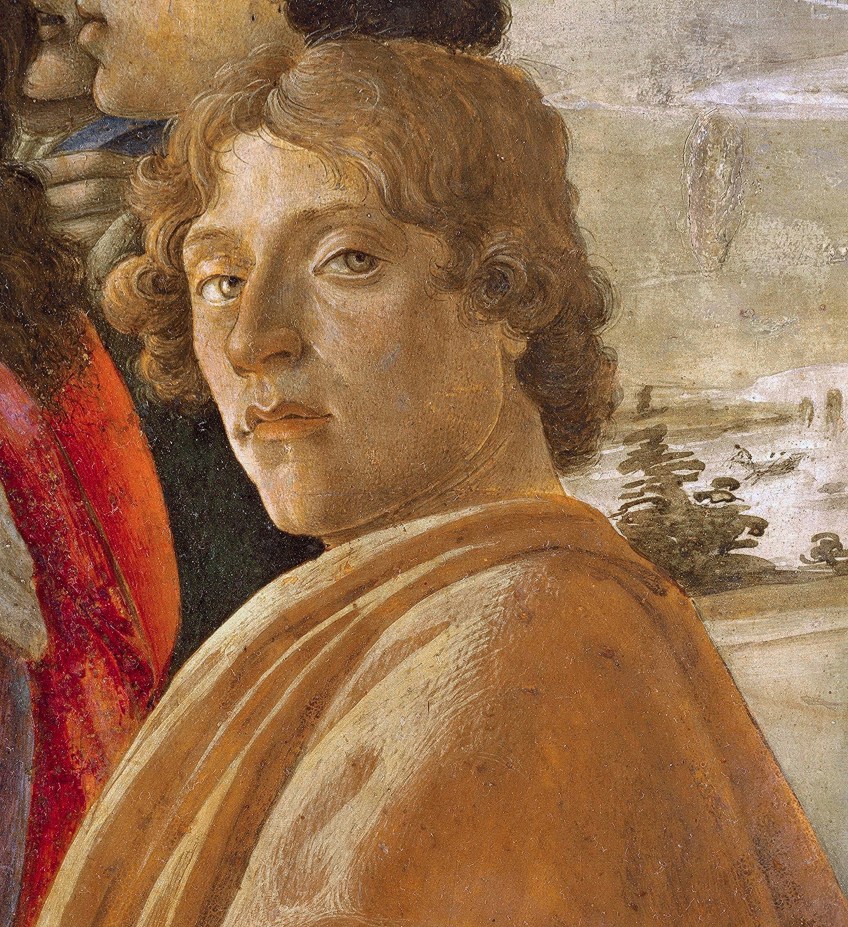 A self-portrait of Sandro Botticelli in his painting Adoration of the Magi (c. 1475);Sandro Botticelli, Public domain, via Wikimedia Commons
A self-portrait of Sandro Botticelli in his painting Adoration of the Magi (c. 1475);Sandro Botticelli, Public domain, via Wikimedia Commons
He was commissioned past wealthy families of Florence similar the Medici family. Pope Sixtus IV too deputed him to paint part of the Sistine Chapel. Botticelli painted religious and mythological field of study matter. His famous artworks include La Primavera (c. 1482 to 1483), Venus and Mars (c. 1483), and The Nascency of Venus (c. 1484 to 1486).
The Birth of Venus by Alessandro Botticelli in Context
The Nascency of Venus painting by Alessandro Botticelli is i of the most famous mythological paintings from the Early Renaissance period. Although Sandro Botticelli was not every bit pop as other artists from the Renaissance, such equally Leonardo da Vinci or Michelangelo, he still contributed one of the most beautiful and sensory-enriching paintings of the goddess Venus.
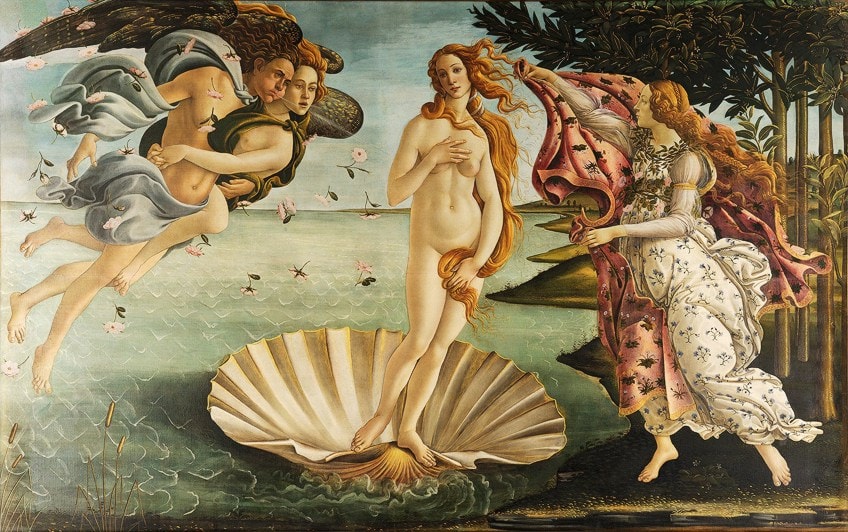 The Nativity of Venus (c. 1485) by Sandro Botticelli; Sandro Botticelli, Public domain, via Wikimedia Commons
The Nativity of Venus (c. 1485) by Sandro Botticelli; Sandro Botticelli, Public domain, via Wikimedia Commons
Below, we will look at the Birth of Venus analysis, starting with a contextual overview of the menstruation surrounding the painting, namely the Early Renaissance (also referred to as the Quattrocento menstruation). We will bear a total exposé of this famous painting and answer diverse related questions similar, who painted The Nascency of Venus? When was The Birth of Venus painted? Where was The Nativity of Venus painted? Where is The Birth of Venus? Who Venus was as a mythological goddess? We will and then discuss the stylistic influences on and approaches taken by Botticelli.
| Artist | Alessandro Botticelli |
| Date Painted | c. 1484 to 1486 |
| Medium | Tempera on canvas |
| Genre | Mythological history painting |
| Period | Early Renaissance |
| Dimensions | 1.72 x ii. 78 meters |
| Series / Versions | It has been believed that it was part of the other painting, La Primavera (c. 1482 to 1483), but it has been reported that it was non its counterpart. |
| Where Is It housed? | Uffizi Gallery, Florence, Italy |
| What It Is Worth | Estimated around $500 1000000 |
Contextual Analysis: A Cursory Socio-Historical Overview
The Birth of Venus painting was created during the 1400s, which was a period in European history that saw a lot of cultural and economical changes. Notable changes that took place during this time included the ending of feudalism, which changed the European economic and social landscape. This was a transitionary period from the Middle Ages (Medieval menses) and art styles progressed from Byzantine to Romanesque and then Gothic.
This progression led to the beginning of the Renaissance, starting with the Proto-Renaissance and then the Early Renaissance. Understandably, a lot of the prior fine art styles still lingered as the Early on Renaissance menstruation became more rooted in newer means of thinking about life and the individual within the globe.
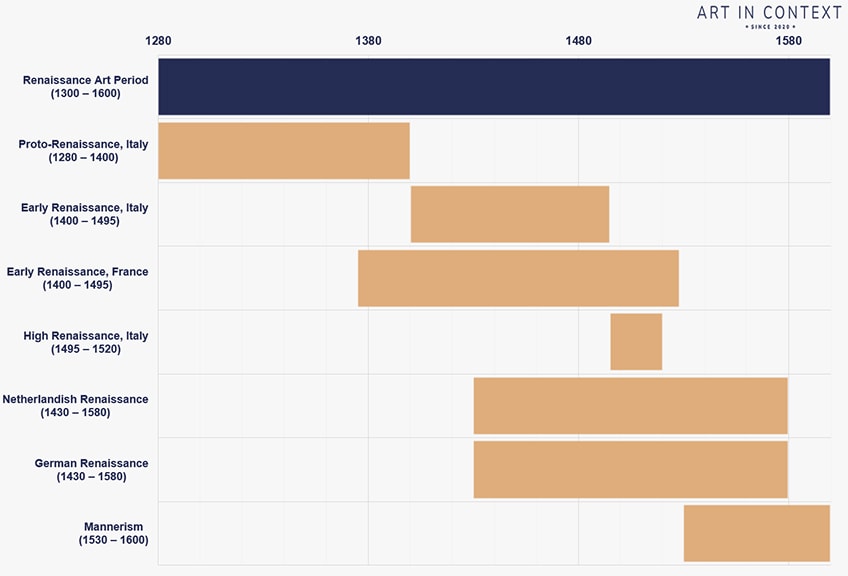 A timeline of the Renaissance menstruum.
A timeline of the Renaissance menstruum.
At that place was a marked difference in the way artists started painting as well, gradually moving away from the flatter, two-dimensional, idealized, and iconographic Byzantine styles. Artists like Cenna di Peppi (Cimabue) and Giotto di Bondone started portraying more than naturalistic subject matter.
These new approaches also fabricated art announced more three-dimensional.
The Renaissance movement took place in Italy and Northern Europe, nonetheless, the Early on Renaissance predominantly occurred in Florence and so Rome during the later years. It was spearheaded by wealthy families, specially the Medici family. They were too avid patrons of the arts and commissioned various artists, including Botticelli, to produce artworks for them.
It is believed that a member of the Medici family commissioned Botticelli to paint The Birth of Venus. Specifically, Lorenzo di Pierfrancesco de Medici, who was a broker and politician and the cousin of Lorenzo the Magnificent, or Lorenzo il Magnifico.
 Portrait of Pierfrancesco de' Medici (1463–1503), called Lorenzo il Popolano;Cristofano dell'Altissimo, Public domain, via Wikimedia Commons
Portrait of Pierfrancesco de' Medici (1463–1503), called Lorenzo il Popolano;Cristofano dell'Altissimo, Public domain, via Wikimedia Commons
Information technology is besides believed that Lorenzo il Magnifico deputed Botticelli'southward other paintings Pallas and the Centaur (c. 1482) and La Primavera (c. 1482 to 1483) as part of a wedding ceremony gift for his cousin. At that place is fence as to who exactly commissioned these paintings.
The Birth of Venus painting was also painted on canvas, which was one of the outset of this type of medium used for painting. Nearly paintings were done on wooden panels, but canvases became more popular because they were cheaper.
Paintings done on canvases were too mainly displayed in homes or villas compared to public buildings.
Therefore, The Birth of Venus was made for domicile display, possibly for the Villa di Castello, which belonged to Lorenzo di Pierfrancesco de Medici in 1486. This is also where La Primavera (c. 1482 to 1483) was housed.
 La Primavera ('Jump', 1480) by Sandro Botticelli;Sandro Botticelli, Public domain, via Wikimedia Eatables
La Primavera ('Jump', 1480) by Sandro Botticelli;Sandro Botticelli, Public domain, via Wikimedia Eatables
However, it is important to note that the Italian art historian Giorgio Vasari saw the to a higher place-mentioned paintings at Castello in 1550. An inventory reportedly discovered in 1975 indicated La Primavera recorded in it, just non The Birth of Venus. Therefore, it is not completely validated who exactly commissioned these paintings or where they were initially housed.
The Birth of Venus was also painted within the context of the popular literature of the time, specifically that of Ovid's Metamorphoses (8 Advertising), Homer's writings, and Agnolo (Angelo) Poliziano's Stanze per la Giostra (1478).
Botticelli was believed to have been influenced past Poliziano because both had some sort of involvement with members of the Medici family at the time.
This also points to a broader characteristic of the period at the time, which is a new way of thinking and perceiving man inside the globe. With the progression of the Renaissance, the Humanist movement gradually emerged. This was based on philosophical thought rooted in the revival of ancient Classical texts from the Greek and Roman cultures.
 The School of Athens (1509–1511) by Raphael, depicting many notable artists, philosophers, and other figures from the Renaissance menstruation; Raphael, Public domain, via Wikimedia Eatables
The School of Athens (1509–1511) by Raphael, depicting many notable artists, philosophers, and other figures from the Renaissance menstruation; Raphael, Public domain, via Wikimedia Eatables
Artists, scholars, and many others were more open-minded about different topics other than strict religious tenets that existed during the Middle Ages. Human'due south capabilities were being questioned inside the larger aspects or macrocosm of that which was considered the universe.
Dissimilar spheres of knowledge were explored and studied, including concepts similar Neo-Platonism, which were based on the philosophical writings of the Greek philosopher, Plato.
Who Was Venus?
Not only was The Birth of Venus by Botticelli a magnificent sheet showcasing a mythological scene and fit for a country villa, merely it also showcased the get-go figure of a nude female in full size. This has not been washed since the times of artifact. We know by the painting's title it was Venus, but who exactly was Venus?
From the many mythological poems from poets similar Ovid, Homer, Hesiod, and Poliziano, to name a few, Venus was the Roman Goddess of love, beauty, prosperity, sex, and many other attributes related to dear. Her name is in Latin, significant "love". Aphrodite was her proper noun in Greek mythology and where the Romans derived their goddess of love.
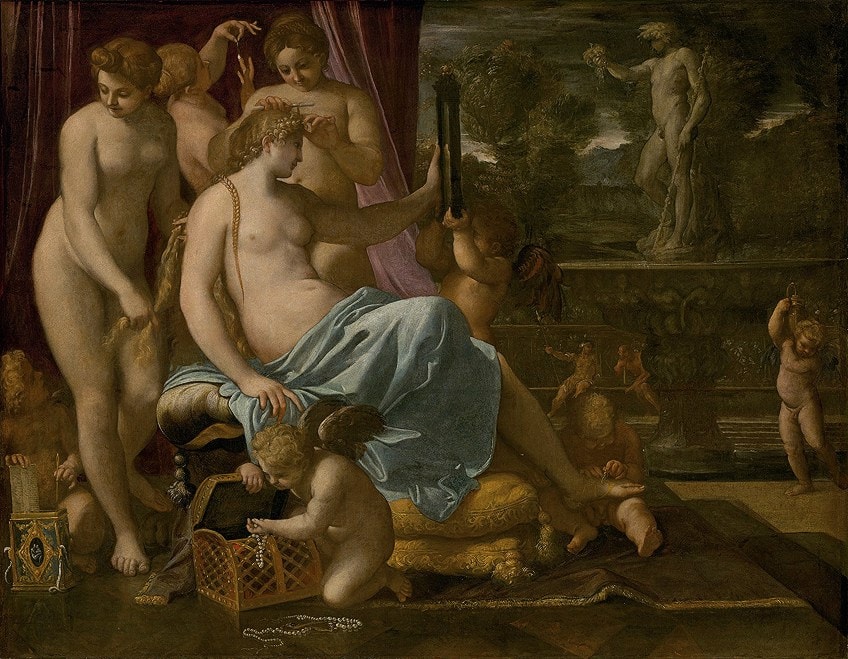 Venus Adorned past the Graces (1590/1595) by Annibale Carracci;National Gallery of Art, CC0, via Wikimedia Commons
Venus Adorned past the Graces (1590/1595) by Annibale Carracci;National Gallery of Art, CC0, via Wikimedia Commons
Venus was born from the foam of the sea after her father, Uranus, was overthrown and castrated by his son Saturn. Uranus was amongst the primal gods in Greco-Roman mythology; he was the god of the sky. Saturn threw Uranus's genitals into the sea, which mixed with the sea foam, thus giving nascence to Venus. Venus' mother, therefore, was the ocean. She was born fully grown.
When she was conceived and born in the sea, she was then blown past the god of the wind, Zephyrus, on a seashell. On the shore is the nymph Chloris, one of the goddesses of the seasons, who are collectively chosen the Horai.
Beneath, nosotros hash out these characters farther.
Formal Analysis: A Cursory Compositional Overview
In the below Birth of Venus analysis, we will look at the compositional and stylistic aspects that make the painting. Start, we volition discuss the subject matter and then wait at Botticelli, who is the artist of the Nascence of Venus, his technique, every bit well as some of the influences and symbolic references that inspired him.
Subject Matter
Looking at the composition of The Birth of Venus painting, nosotros find the nude figure of Venus in the central position. She stands on a large scallop shell covering her breasts with her correct manus and her left hand and long pilus encompass her genitals.
Her head is tilted to her right side and her body posture is like that of a contrapposto-styled stance.
Venus is depicted every bit the embodiment of beauty; her skin is shine and milky in color without whatsoever blemish. Her hair is also golden and hangs almost the full length of her body. This hairstyle is as well reported to have been inspired by women's hairstyles of the time Botticelli lived.
 A detail of Venus from Botticelli'south The Birth of Venus, c. 1485;Sandro Botticelli, Public domain, via Wikimedia Eatables
A detail of Venus from Botticelli'south The Birth of Venus, c. 1485;Sandro Botticelli, Public domain, via Wikimedia Eatables
To Venus' right (our left) are two figures in the air, busy blowing towards Venus. They have been identified every bit the Greek god Zephyr, associated with the west winds. He was one of the gentler winds, associated with the beginnings of Spring.
Belongings on to Zephyr, her artillery wrapped around his waist is Aura, which means "breeze". Information technology could also exist Zephyr's wife, Chloris, a nymph of the Jump season and its associated aspects. Both figures appear with cute and large wings and billowing drapery covering their bodies.
Nosotros know they personify the wind and breeze through their activity of blowing and the lightly painted lines symbolizing the wind coming out of their mouths.
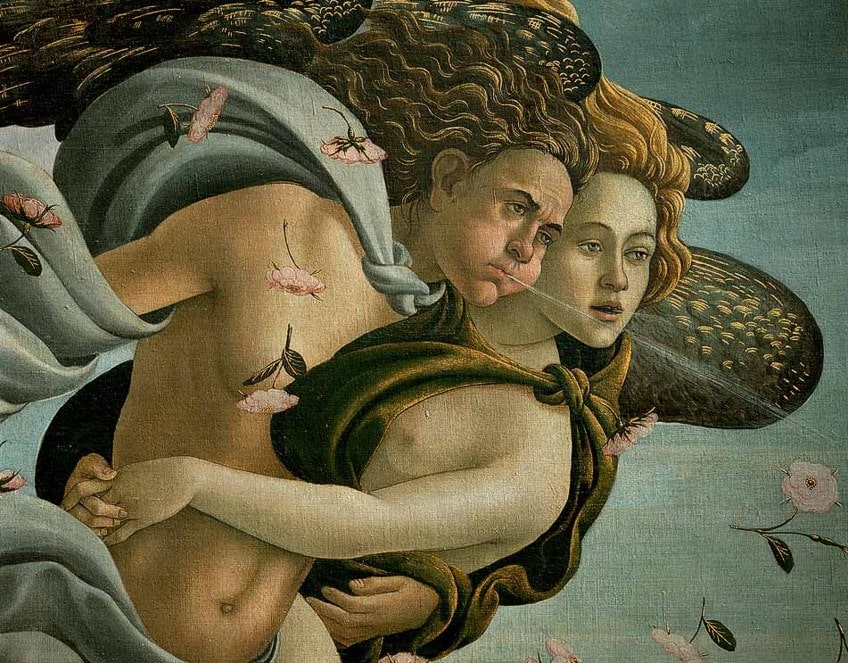 A detail of Chloris and Zephyrus from Botticelli's The Nascency of Venus, c. 1485; Sandro Botticelli, Public domain, via Wikimedia Commons
A detail of Chloris and Zephyrus from Botticelli's The Nascency of Venus, c. 1485; Sandro Botticelli, Public domain, via Wikimedia Commons
To Venus' left (our right) there is another female figure on the shore, waiting to meet her. She holds out a florally busy cloak to cover Venus. This figure is identified as ane of the Horae, which are the goddesses of the seasons, specifically the Hora of Spring due to the floral patterns and flowers on her dress.
She also stands very lightly on the grassy shore; some sources too suggest she may exist floating.
 A detail of the Hora holding out a cloak for Venus from Botticelli's The Birth of Venus, c. 1485; Sandro Botticelli, Public domain, via Wikimedia Eatables
A detail of the Hora holding out a cloak for Venus from Botticelli's The Birth of Venus, c. 1485; Sandro Botticelli, Public domain, via Wikimedia Eatables
The surrounding mural is dissever between the light blue of the ocean, making up nearly of the left of the composition. Information technology meets the grassy shoreline on the correct-hand side of the limerick, which extends into what appears to exist a hilly landscape with various scattered trees in the altitude. There is a forest in the right foreground where the Hora of Jump awaits. Orange blossoms decorate the trees. Other blossoms are blown towards Venus every bit she reaches the shore, these include beautiful pink roses with aureate centers.
We will notice at that place are various areas of the composition with gilded areas. For example, the shoreline where she volition pace off to walk, her shell is also rimmed with gold, as well as the trees and their blossoms.
Technique: Color and Low-cal
Botticelli used the tempera painting technique, which consists of combining color pigments with a water-soluble medium diluted with a binding medium, which was usually egg yolk. This was different from fresco paintings; however, many sources indicate that this painting has the "freshness" of a fresco. Information technology has been well-preserved over the centuries.
Botticelli used softer more earthy color tones set complimentary to the other, for example, the cerise drape to the right and the light-green and blue from the curtain of the two figures to the left. Venus herself is portrayed in the lighter skin tones directly linked with her being a symbol of beauty and perfection.
 The apply of colour and light is illustrated in this close-up of Venus from Botticelli'due south The Birth of Venus, c. 1485; Sandro Botticelli, Public domain, via Wikimedia Eatables
The apply of colour and light is illustrated in this close-up of Venus from Botticelli'due south The Birth of Venus, c. 1485; Sandro Botticelli, Public domain, via Wikimedia Eatables
The surrounding landscape is likewise rich in color tones, for instance, the cooler colors like the low-cal bluish of the ocean and sky run across the warmer and deeper color tones and shades of green and chocolate-brown from the land. There is also more shading around the right side of the painting every bit we arroyo the forested expanse.
It nearly appears equally if we move from a lighter side of the composition to a darker side, from sea to land, from nascency to life. This adds depth and chromatic balance to the composition.
Perspective and Line
Botticelli is noted for using dark outlines in the Birth of Venus painting, this takes precedence over the colors used. In this painting, line directly influences perspective. We specifically find the dark outlines around the figures, the two figures to the left and Venus, all standing with a light background backside them, which is what creates a contrast. This besides emphasizes Venus' milky skin tones and beauty – we could almost say that Venus is venerated inside Botticelli'south bolder outlines.
The utilise of darker outlines also creates a lack of depth to the painting, creating more than two-dimensionality. We come across the darker horizon line in the groundwork and the figures take no shadows, all of which add to a full general flatness of the composition.
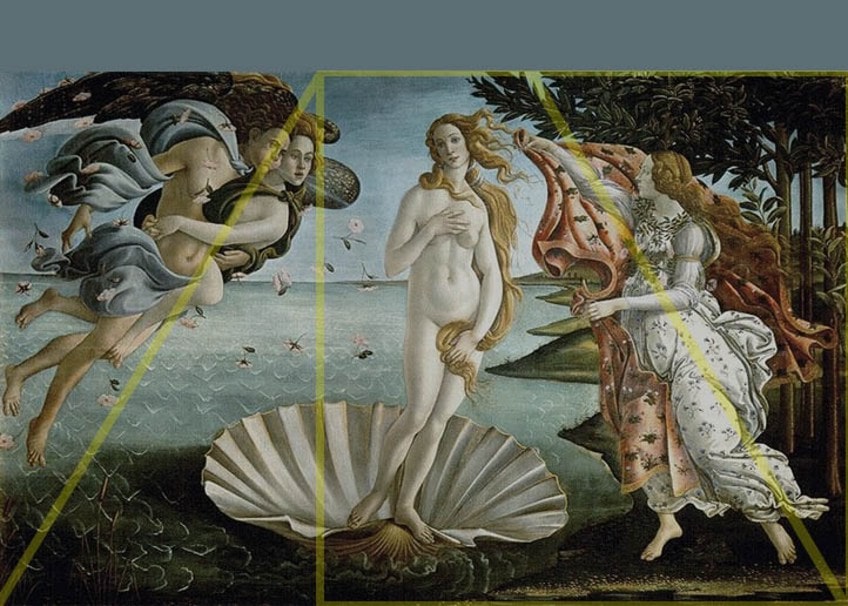 The Golden Ratio as seen in The Nascence of Venus (c. 1485) by Sandro Botticelli; Sandro Botticelli, Public domain, via Wikimedia Commons
The Golden Ratio as seen in The Nascence of Venus (c. 1485) by Sandro Botticelli; Sandro Botticelli, Public domain, via Wikimedia Commons
There are a few elements that advise a sense of depth and movement, such as in the white chevron-like shapes on the body of water. In the background, these appear well-nigh similar small-scale dots on the surface of the sea and as we motility closer to the shore it increases in shape and size.
These shapes advise the thought of waves and create more dynamism to the painting, especially near the rim of Venus' beat by her feet, where the h2o is painted in curling splashes.
Depth is besides evident in the mural; we see this in the green hills and smaller scattered trees in the far background of the composition. This suggests the idea of altitude seen from the foreground shore, where most of our attention is fatigued to. If we look closely, the horizon line in the far distance is also a darker outline, and the similar colors of the heaven and the bounding main creates more than flatness, similarly, there is likewise little sense of depth where the h2o and country join.
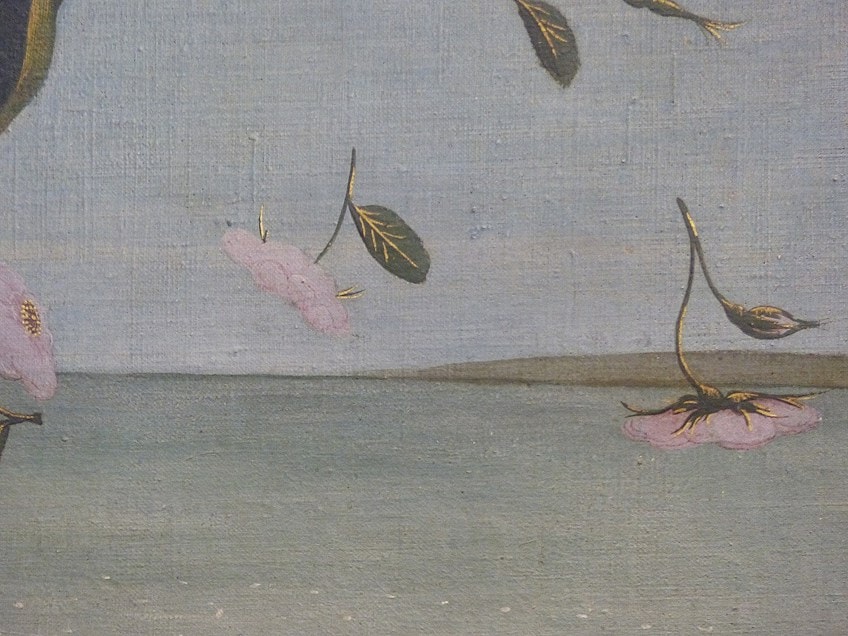 Details of The Birth of Venus (c. 1485) past Sandro Botticelli; Benjamín Núñez González, CC By-SA iv.0, via Wikimedia Eatables
Details of The Birth of Venus (c. 1485) past Sandro Botticelli; Benjamín Núñez González, CC By-SA iv.0, via Wikimedia Eatables
There are other areas where Botticelli uses line to show three-dimensionality and more dynamism, as in Venus' clamshell and the drapery of the figure on the right, besides as the cloak she holds up for Venus, which is portrayed in flowing lines suggesting the billowing from the wind to the left. Venus' hair is another instance and one of the chief attractions of this painting, not only depicted in a aureate strawberry color but also long and lustrous, billowing in the wind.
Proportions
The figure of Venus is also portrayed with exaggerated anatomy, overall, her body is quite elongated. We see this elongation emphasized in her neck and in the depiction of her arms, mostly her left (our right) arm covering her genitalia with her pilus.
Furthermore, her stance is unrealistic as she leans too far to her left side without anything supporting her. In a more realistic setting, she would fall over. This elongation and inaccurate portrayal of proportion and opinion heighten Venus' dazzler and her as almost an otherworldly figure that has just been given life.
It besides points to the stylistic influences on Botticelli at the fourth dimension, which we will discuss farther below.
Scale
The painting is big in calibration, measuring 1.72 x two.78 meters. It is too slightly smaller than Botticelli's La Primavera (c. 1482 to 1483). If it was the case where this painting was fabricated for the Medici family unit, it was made to beautify a wall infinite perfectly fit for private living space compared to public spaces.
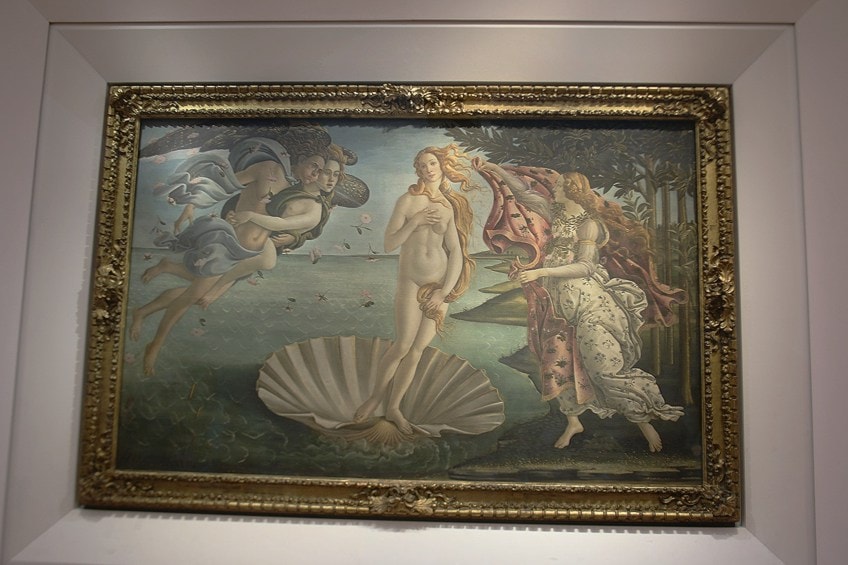 A photograph of Botticelli'due south The Nativity of Venus on a wall in the Uffizi Gallery in Florence, Italy, illustrating its large size; FrDr, CC By-SA iv.0, via Wikimedia Commons
A photograph of Botticelli'due south The Nativity of Venus on a wall in the Uffizi Gallery in Florence, Italy, illustrating its large size; FrDr, CC By-SA iv.0, via Wikimedia Commons
Stylistic Influences
Botticelli did not depict his paintings with the same level of perspectival acuity nosotros see from other Renaissance artists. He did not prescribe to the heightened sense of naturalism that was so characteristic of the time, his figures appear nigh weightless similar they are floating.
Some of his stylistic influences that contributed to how he portrayed perspective, infinite, and figure's stances in his paintings came from the Byzantine and International Gothic styles.
There is a sense of decorativeness in his style with lighter colour schemes and idealized anatomical features, all seeming to focus more than on appealing to sensory pleasure and aesthetics rather than the thought of staying true to nature every bit we run across from artists like Leonardo da Vinci, such equally in his rendition of biblical figures like Mother Mary, like his Virgin of the Rocks (1484 to 1486). This is besides seen with other contemporaries of Botticelli'due south like Domenico Ghirlandaio.
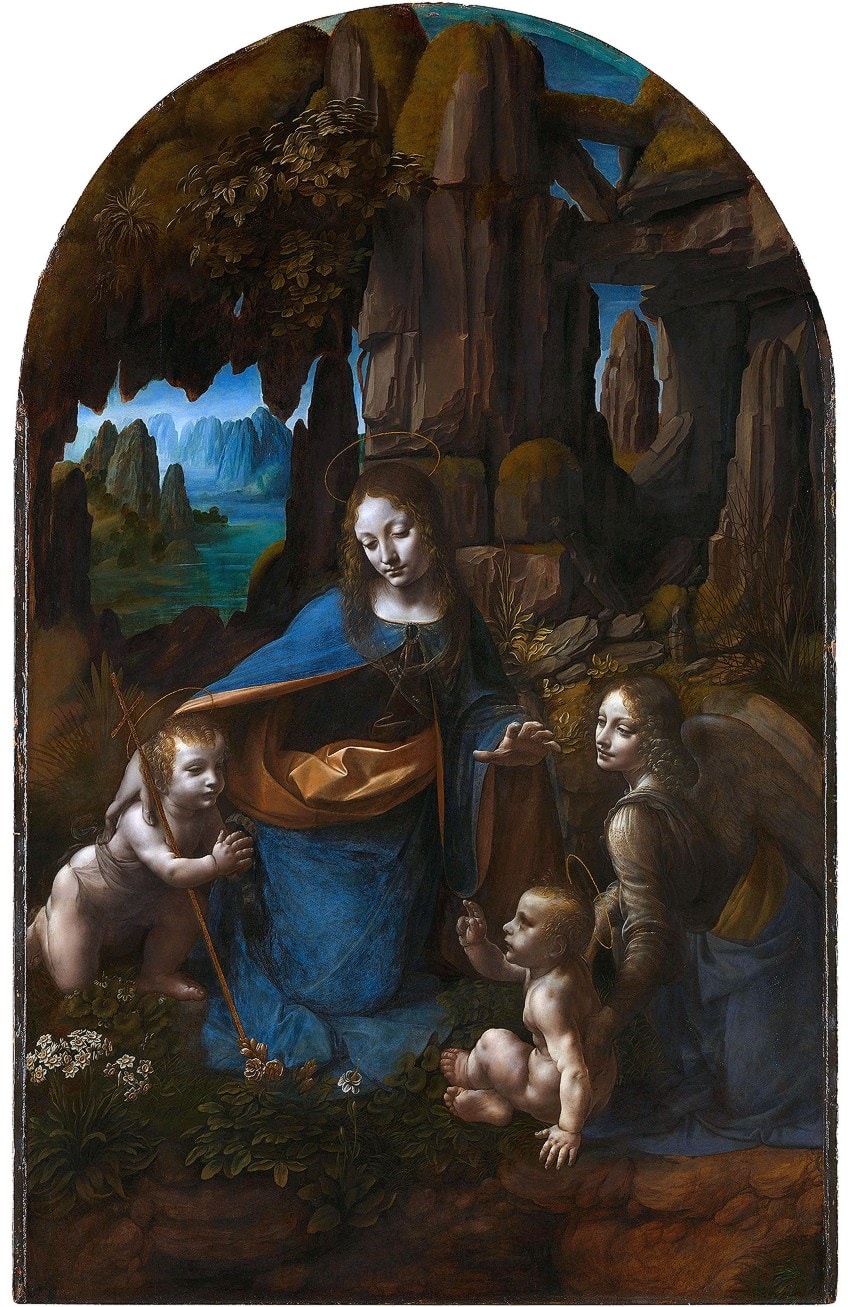 Virgin of the Rocks (1484-1486) past Leonardo da Vinci;Leonardo da Vinci and workshop, Public domain, via Wikimedia Commons
Virgin of the Rocks (1484-1486) past Leonardo da Vinci;Leonardo da Vinci and workshop, Public domain, via Wikimedia Commons
The figure of Venus and her gestural style is as well believed to accept been taken from the sculptural way Venus Pudica. In fact, Botticelli has crafted his feminine figure almost like a marble statue painted on sheet. This is as well reminiscent of the Classical era's Greco-Roman sculptures of female person nudes.
"Venus Pudica" is a descriptor term for a Classical female person pose where the female covers her genitalia with i mitt and stands in an asymmetrical opinion, nigh unnaturally.
The manner she meekly covers herself, ironically, draws attending to the areas she is covering. The give-and-take pudica originates from the Latin pudenda, which relates to external ballocks or the concept of shame or feeling shameful, all of which are reflected in the countenance of the bashful Venus depicted above.
 Re-create of Aphrodite of Cnidus by Praxiteles, 4th century;Museo nazionale romano di palazzo Altemps, Public domain, via Wikimedia Eatables
Re-create of Aphrodite of Cnidus by Praxiteles, 4th century;Museo nazionale romano di palazzo Altemps, Public domain, via Wikimedia Eatables
We run across Botticelli's Venus emulating the same features as those of the Aphrodite of Knidos (Cnidus) (c. 4th century BC) by the Greek sculptor Praxiteles of Athens. He was one of the first sculptors to portray the female person figure in the nude and was lauded as one of the nigh innovative sculptors of his fourth dimension due to this. Praxiteles'southward sculpture depicts Aphrodite holding a bath towel in her left hand covering her genitalia with her correct hand, however, her breasts are still exposed.
This sculpture also juxtaposes the classical male figure in sculpture, which was focused on portraying heroism.
Symbolic Interpretations
Information technology is worth noting that the Nativity of Venus past Botticelli has had numerous dissimilar symbolic meanings and interpretations. As mentioned above, some interpretations come up from the Neo-Platonic thought of the Humanist move during the Renaissance. Below we expand on this a scrap more.
Neo-Platonism
Venus was too regarded in Neo-Platonic thought as a symbol for physical and spiritual love equally described by the aboriginal Greek philosopher, Plato. Information technology is believed that the Birth of Venus painting was meant to arm-twist a contemplative response in viewers. In other words, when viewing Venus, her concrete beauty portrayed would exist a reminder of the ideas of divine love.
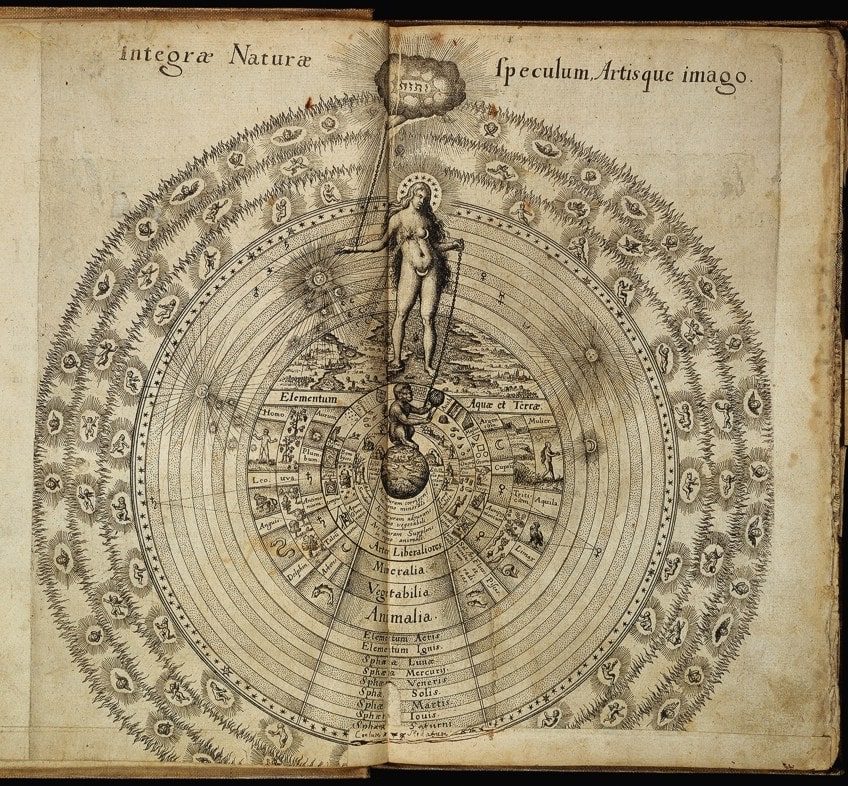 A diagram illustrating the Neo-Platonic principles of the metaphysical, physical, and technical history of each major and minor cosmos, c. xiv/15th century;Run across page for writer, CC By iv.0, via Wikimedia Eatables
A diagram illustrating the Neo-Platonic principles of the metaphysical, physical, and technical history of each major and minor cosmos, c. xiv/15th century;Run across page for writer, CC By iv.0, via Wikimedia Eatables
The Humanist movement allowed a more open up manner of perceiving the world and the bailiwick matter was more "infidel" compared to the traditional religious subject field matter. This type of secularity was deemed acceptable.
This philosophical thought was also reportedly present and expert inside the Medici courtroom, so information technology is within reason that these above-mentioned interpretations are interrelated.
Christian Interpretation
It is likewise important to annotation the cultural context in which the Nascency of Venus painting was created, not but was it nestled within a newly emerging cultural enkindling that promoted ideas across that of the church building and bible, but it was all the same inside a time of stiff religious changes and religion would have certainly still played a part.
Some sources also describe the Christian interpretation for Botticelli's Nativity of Venus and that it is symbolic of and influenced past the Baptism of Christ. It is compared to 2 other Renaissance paintings to illustrate this thought, namely, Giotto's The Baptism of Christ (c. 1305) and Piero Della Francesca's painting of the aforementioned proper noun (1448 to 1450).
The structural limerick follows Christ equally the key figure, the angels to his right (our left), and John the Baptist to his left (our right).
 LEFT: No. 23 of Scenes from the Life of Christ: 7. Baptism of Christ (1304-1306) by Giotto di Bondone; Giotto, Public domain, via Wikimedia Eatables | RIGHT: Baptism of Christ (1448-1450) by Piero della Francesca; Piero della Francesca, Public domain, via Wikimedia Commons
LEFT: No. 23 of Scenes from the Life of Christ: 7. Baptism of Christ (1304-1306) by Giotto di Bondone; Giotto, Public domain, via Wikimedia Eatables | RIGHT: Baptism of Christ (1448-1450) by Piero della Francesca; Piero della Francesca, Public domain, via Wikimedia Commons
In the Birth of Venus, nosotros run into this exact structure, however, Christ is replaced by Venus, the angels are replaced by the current of air god Zephyr and his companion Chloris (or Aura), and John the Baptist is replaced past the Hora of Spring holding the cloak to cover Venus.
The gesture of the Hora of Spring and John the Baptist is seemingly similar in nature because both figures (religious and secular) approach the sacred central figure with the intention to beautify or bless them, in this case, a baptism and a protective cloak to cover Venus.
Other Christian interpretations propose it alludes to the Garden of Eden and Venus as a symbol of Eve'south nudity.
She could also be a symbol of mortality, which is symbolized by the cloak, every bit before long equally she puts it on, she becomes mankind and represents the Church building that will be a conduit for salvation. Furthermore, Venus is besides believed by some to be a symbol of Mother Mary, who is also known equally Stella Maris pregnant "Star of the Ocean", which is further alluded to by the emphasis on Venus coming from the sea. In this case, Venus is regarded as the divine aspect of Stella or "star," and Mary is alluded to by the visual depiction of the sea, or Maris.
For Flattery
Other sources suggest The Birth of Venus painting was made to flatter the head of the Medici family unit, Lorenzo de Medici. Some believe the figure of Venus was made in the likeness of Simonetta Cattaneo Vespucci, who was the wife of the Florentine merchant, Marco Vespucci. She is believed to have been born in the town called Porto Venere, which means "Port of Venus" on the Ligurian coast located in Italy.
She was regarded as one of the most beautiful women with the nickname "La Bella Simonetta". Lorenzo de Medici and his brother, Giuliano, both held her in high esteem and adoration.
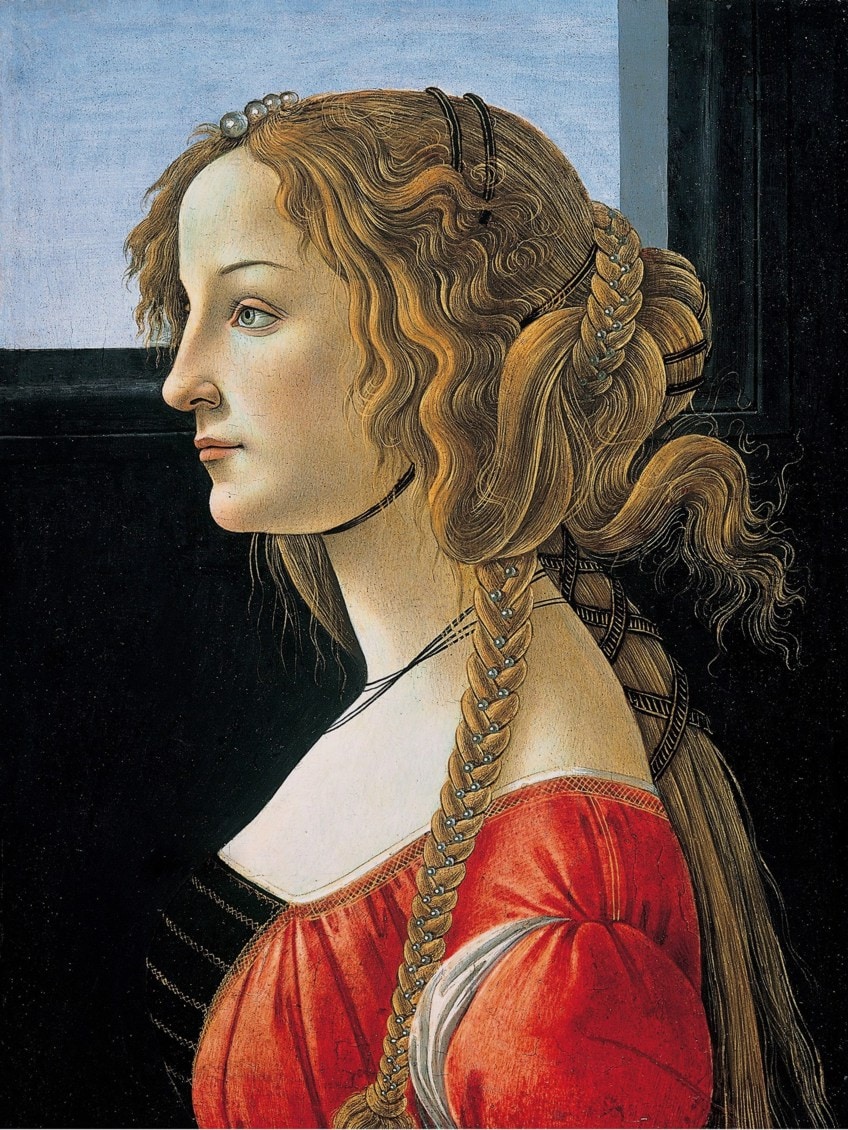 Contour portrait of a young woman (probably Simonetta) (between 1475 and 1480) by Sandro Botticelli, depicting Italian noblewoman Simonetta Vespucci;Workshop of Sandro Botticelli, Public domain, via Wikimedia Eatables
Contour portrait of a young woman (probably Simonetta) (between 1475 and 1480) by Sandro Botticelli, depicting Italian noblewoman Simonetta Vespucci;Workshop of Sandro Botticelli, Public domain, via Wikimedia Eatables
There is also speculation that she was the above-mentioned Medicis' mistress, which also alluded to Alexander the Great's mistress, Campaspe (or Pancaste) painted by the aboriginal Greek painter, Apelles of Kos. Botticelli could accept been regarded as continuing the work done by Apelles. Yet, this is but another historical and political reference within The Birth of Venus painting.
A Circuitous Dazzler
Botticelli's Birth of Venus painting runs as deep as the ocean'southward waters where Venus was born. While it is regarded as visually simple to analyze and interpret, giving us all the facts through the placements of the figures and who they are, there is an undercurrent in this Early on Renaissance painting that suggests so much more than.
The symbolic meaning of this Venus can be considered a complex one as information technology holds various interpretations that relate to Greco-Roman mythology, Christian religion, politics, history, philosophy (remember Neo-Platonism and the Humanism motility), and undoubtedly wealth and weddings in prominent Italian families.
"The Birth of Venus" painting is an Early Renaissance masterpiece, holding not only the immaculately defined Venus on her golden scallop shell, arriving on the shores, merely also the immaculate artistry of a painter that was not well-known for his fourth dimension, but who poured out the depths of his soul onto his canvas, giving us a sensory experience similar no other. We are unabashedly faced with Venus and her entourage taking the centerstage of this artwork.
Accept a look at ourBirth of Venuswebstory hither!
Oftentimes Asked Questions
Who Painted The Birth of Venus?
The Nativity of Venus (c. 1484 to 1486) painting was made by Alessandro Botticelli, who was an artist from the Early on Renaissance period in Italy. Although Sandro Botticelli was not as pop as other artists from the Renaissance like the Loftier Renaissance painters Leonardo da Vinci or Michelangelo, he contributed one the most sensory enriching paintings of mythological discipline matter, specifically of the goddess Venus.
When Was The Nascency of Venus Painted?
The Birth of Venus was painted effectually 1484 to 1486. This was during the Early Renaissance period in Italy, a catamenia that spanned the 1400s. It was likewise referred to every bit the Quattrocento period, which was after the Middle Ages and Proto-Renaissance menses and preceded the latter part of the Renaissance called the Loftier Renaissance.
Where Is The Nascence of Venus?
Before long, The Birth of Venus (c. 1484 to 1486) painting is housed at the Uffizi Gallery in Florence, Italy. Information technology is believed that the painting was requested past the Medici family every bit a wedding present. They deputed Alessandro Botticelli, who is the artist of the Nascence of Venus. Some sources report it was housed in the Villa Castello until 1815, which belonged to Cosimo I de Medici, this is where La Primavera (c. 1482 to 1483) was also housed.
Where Was The Birth of Venus Painted?
Information technology is believed that later Sandro Botticelli worked on frescoes for the Sistine Chapel in Rome in 1481, he returned to his city of birth, Florence, where he started painting more secular subject matter. This included mythological discipline affair from the Greek and Roman era. Information technology was here that Botticelli was commissioned to paint The Nativity of Venus, which was from 1484 to 1486.
Source: https://artincontext.org/the-birth-of-venus-botticelli/
0 Response to "Symbolic Meaning of Showing One Breast in Greek Art"
Enregistrer un commentaire